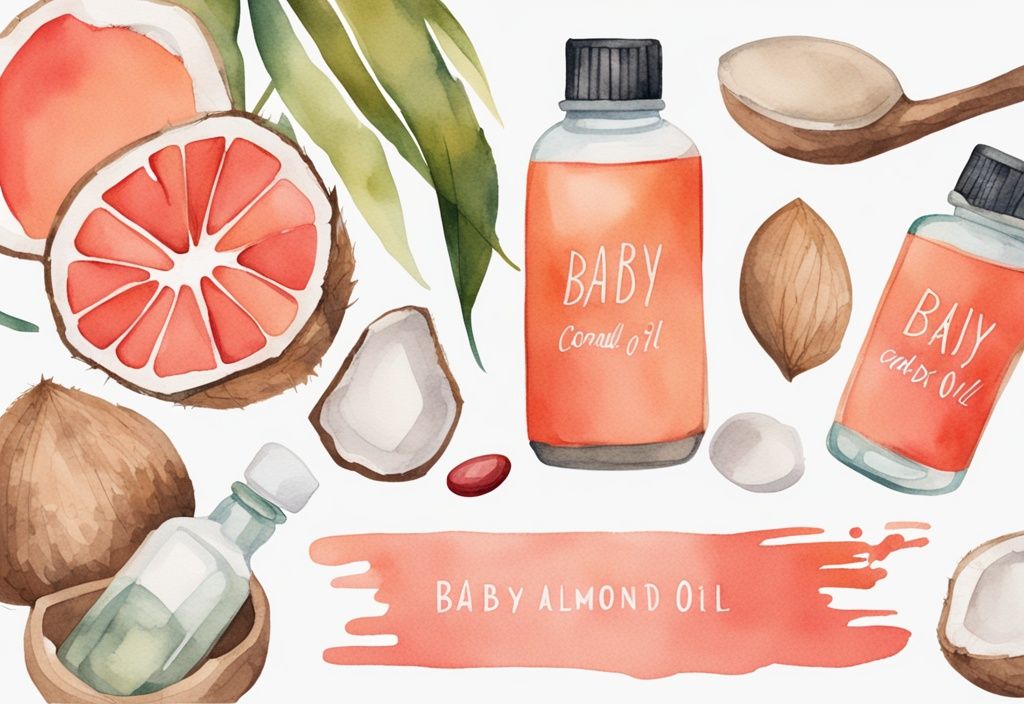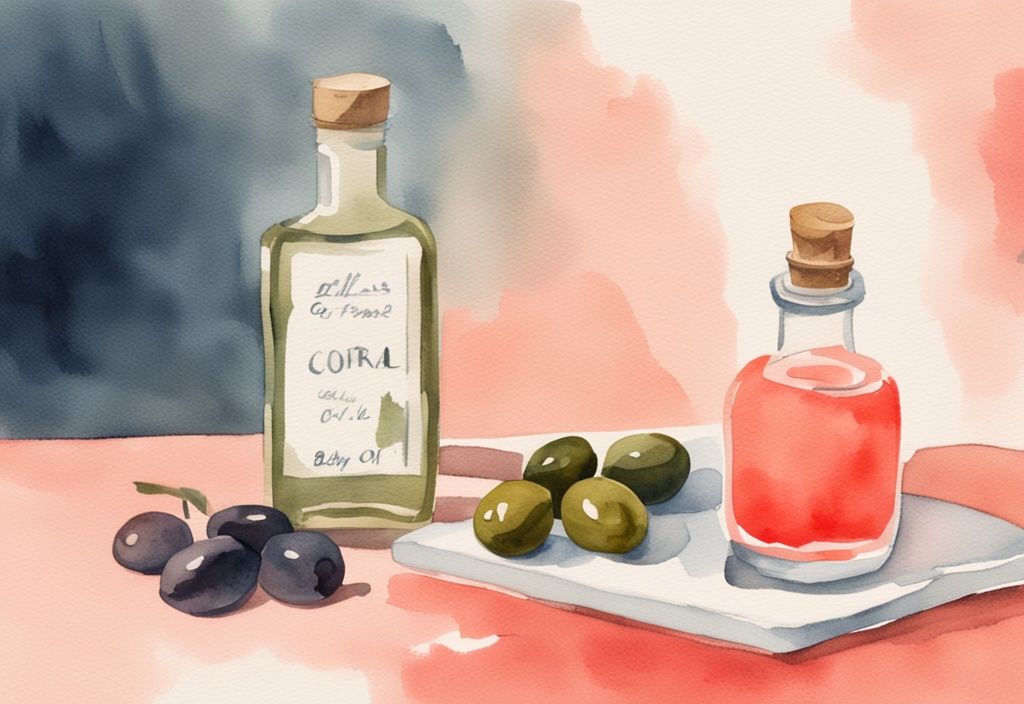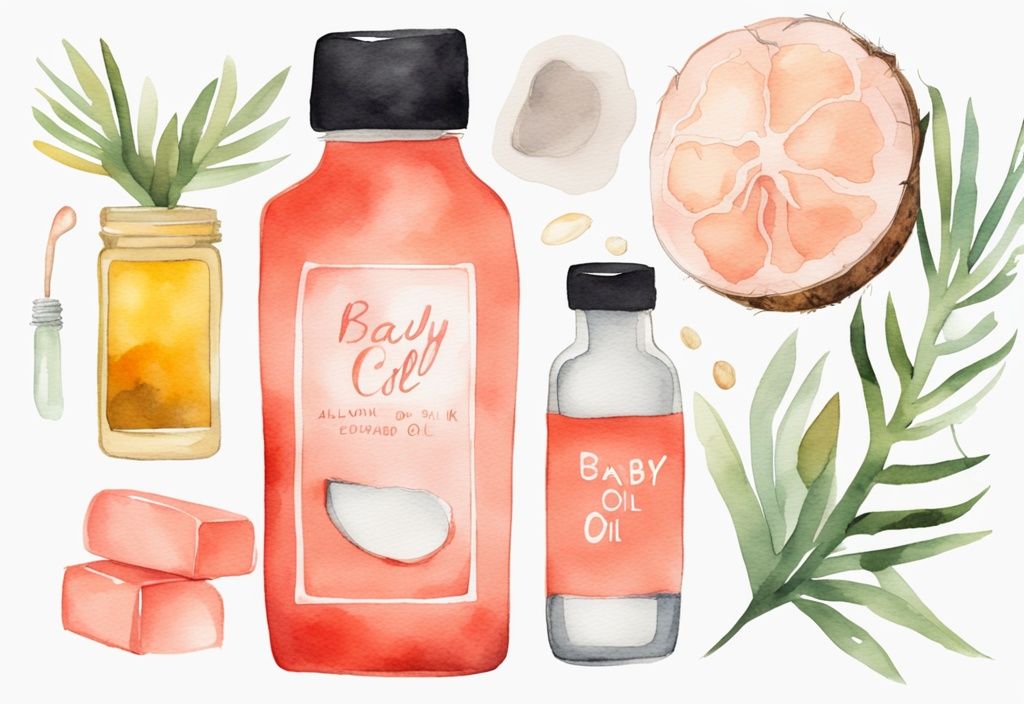Did you know that many commercial baby oils contain mineral oil, which can be harsh on your little one’s sensitive skin? Hi there, fellow parents! It’s Mia here, and today, I’m going to show you how to make your own baby oil at home. It’s a natural, safe, and cost-effective solution that gives you complete control over what goes onto your baby’s skin.
In this guide, you’ll learn how to craft a gentle and nourishing baby oil that’s perfect for your baby’s needs. It’s easier than you think, and I bet you already have some of the ingredients in your kitchen. So, let’s dive in and start protecting those precious little cheeks!
Remember, we’re in this parenting journey together. Let’s make baby care a joy, not a chore.
Why Make Your Own Baby Oil?
Creating your own baby oil at home offers numerous benefits, especially when considering the sensitive nature of a baby’s skin. Commercial baby oils frequently contain mineral oil, a byproduct of crude oil, which might not be the best choice for delicate skin. By learning how to make baby oil yourself, you gain complete control over the ingredients, ensuring that only natural and safe components are used. This approach not only provides peace of mind but also allows for customization to meet your baby’s specific skin needs.
Moreover, making baby oil at home can be a cost-effective alternative to purchasing commercial products. Many parents find that they already have the necessary ingredients, such as natural oils, in their pantry, which reduces the need for additional purchases. This DIY method not only saves money but also ensures that you are using fresh, high-quality ingredients. By understanding how to make baby oil, you are taking a proactive step in providing gentle and nurturing care for your baby’s skin, free from potential allergens and harsh chemicals often found in store-bought options.
The Benefits of DIY Baby Oil
Hey there, fellow parents! Have you ever thought about the magic of creating your own baby oil at home? When you dive into the world of how to make baby oil, you’re opening up a treasure trove of natural goodness for your little one’s skin. Imagine being able to handpick pure, natural ingredients, steering clear of those pesky synthetic additives and preservatives. It’s like giving your baby’s delicate skin a gentle hug, minimizing the chances of irritation or those unwelcome reactions.
One of the delightful perks of DIY baby oil is the sheer flexibility it offers. Every baby’s skin is as unique as their giggles, and by crafting your own baby oil, you can tailor the ingredients to meet those special needs. Whether your little one has dry skin, sensitive skin, or is prone to certain conditions, you can choose oils and additives that provide the best care and protection. It’s all about making sure your baby feels comfy and loved.
Plus, let’s talk about the peace of mind that comes with reducing exposure to potential allergens and harsh chemicals. Many store-bought baby oils are packed with mineral oils and artificial fragrances. By opting for natural ingredients, you’re ensuring a safer and more soothing experience for your baby. It’s like wrapping them in a cozy, chemical-free blanket.
Incorporating the knowledge of how to make baby oil into your parenting routine isn’t just about peace of mind; it’s also a fantastic way to save a few bucks. With the right ingredients, you can whip up a high-quality product that stands shoulder to shoulder with commercial options. And let’s be honest, who doesn’t love a little cost-effective magic that keeps our babies’ skin happy and healthy?
Choosing Natural Ingredients for Baby’s Safety
When you’re diving into the world of how to make baby oil, it’s like embarking on a little adventure to find the best natural ingredients for your baby’s precious skin. Trust me, as a mom of two, I’ve been there, and I know how important it is to keep things gentle and safe. Natural oils like olive oil, coconut oil, and sweet almond oil are my go-to choices. They’re like a warm hug for your baby’s skin, providing moisture and protection without any nasty chemicals sneaking in.

Now, let’s talk about adding a little extra magic with essential oils. These can be wonderful but remember, a little goes a long way! Always mix them with a carrier oil to avoid any skin irritation. Think of it like adding a sprinkle of love to your homemade baby oil. Lavender or chamomile can bring soothing vibes, making your baby oil extra special.
Oh, and here’s a friendly reminder: watch out for those sneaky allergens. Even natural ingredients can sometimes cause a fuss on sensitive skin. If you’re ever in doubt, don’t hesitate to chat with a professional. By carefully picking and blending these natural goodies, you’ll whip up a baby oil that’s just right for your little one’s unique needs. You’re doing great, and your baby will thank you with those adorable giggles!
Essential Ingredients for Homemade Baby Oil
Creating baby oil at home is a delightful journey into the world of gentle skincare. Each ingredient plays a special role in nurturing your baby’s delicate skin, ensuring it stays soft, protected, and healthy. Let’s explore some key components that make homemade baby oil a loving choice for your little one.
Understanding Carrier Oils and Their Benefits
When you’re diving into how to make baby oil, getting to know carrier oils is like discovering a secret ingredient in your favorite recipe. These oils are the backbone of any baby oil blend, offering the hydration and protection that delicate skin craves. They don’t just nourish; they also make sure essential oils are gentle enough for sensitive skin. It’s like having a double-duty friend in your skincare routine, always ready to lend a hand.
Why Choose Sweet Almond Oil?
Sweet almond oil is like that friend who always brings a smile to your face. When you’re figuring out how to make baby oil, this oil stands out for its gentle touch and vitamin E richness. It keeps the skin soft without causing any fuss, which is perfect for your baby’s sensitive skin. Plus, its hypoallergenic nature means fewer worries about irritation. Sweet almond oil is a trusty companion in your homemade baby oil adventures, offering nourishment and protection with a gentle hug.
Coconut Oil: A Safe Choice for Baby’s Skin
Coconut oil is like a comforting blanket for your baby’s skin. When you’re exploring how to make baby oil, its antimicrobial properties make it a standout choice. It tackles dryness and soothes irritation, all while providing a protective barrier against the world. Its thicker consistency is like a cozy shield, keeping your baby’s skin safe from environmental stressors. With coconut oil, you’re wrapping your little one in a layer of love and care.
Jojoba Oil: A Natural Moisturizer
Jojoba oil is like a gentle whisper of nature’s magic in your quest to understand how to make baby oil. It mimics the skin’s own oils, creating a breathable barrier that doesn’t weigh down the skin. Its non-greasy feel and quick absorption make it a favorite for parents who want a light yet effective moisturizing solution. Jojoba oil strikes the perfect balance, ensuring your baby’s skin stays soft and supple without any heaviness. It’s like a gentle breeze on a sunny day, refreshing and comforting all at once.
Adding Essential Oils for Extra Care
Creating your own baby oil at home can be a rewarding experience, especially when you know exactly what’s going into it. Essential oils can add that extra touch of care, turning your homemade concoction into something truly special for your little one’s delicate skin. Let’s explore some wonderful options that can elevate your baby oil.
Lavender Oil: Soothing and Calming
Ah, lavender oil! It’s like a gentle hug from nature. When you’re figuring out how to make baby oil, lavender is a lovely choice because of its calming properties. Imagine your baby drifting off to sleep, enveloped in a soothing aroma. But remember, a little goes a long way. Its fragrance is strong, so use it sparingly to create a gentle, comforting effect that enhances your DIY baby oil. For more insights on using essential oils safely with babies, check out this helpful resource: https://www.healthline.com/health/parenting/essential-oils-for-babies.
Chamomile Oil: Perfect for Sensitive Skin
Chamomile oil is a gem for sensitive skin. It’s like a soft whisper of comfort for your baby’s delicate skin. Known for its anti-inflammatory magic, chamomile can soothe irritation like a pro. When you’re thinking about how to make baby oil, consider chamomile for its gentle touch. Just be sure to dilute it properly, ensuring it’s both safe and effective. By adding chamomile, you’re offering a natural solution that truly understands your baby’s skin needs.
Calendula Oil: Nature’s Skin Healer
Calendula oil is nature’s little healer. When you’re on the journey of discovering how to make baby oil, calendula is a fantastic companion. It’s celebrated for its ability to repair and soothe, making it a gentle yet powerful choice. Calendula’s nurturing nature means it provides essential skin benefits without any harshness. By incorporating it, you’re enhancing your homemade baby oil with a touch of nature’s finest care, ensuring your baby’s skin feels loved and protected.

Step-by-Step Guide: Making Your Own Baby Oil
Creating your own baby oil at home can be a rewarding experience, allowing you to customize it to suit your little one’s unique needs. In this guide, we’ll explore simple recipes and tips to help you craft a nourishing and gentle baby oil.
Easy DIY Baby Oil Recipe
Learning how to make baby oil at home is not just straightforward; it’s a delightful way to ensure you’re using the best ingredients for your baby’s delicate skin. Picture this: you’re in your kitchen, selecting a carrier oil like sweet almond, coconut, or jojoba oil. These oils are like a warm hug for the skin, known for their moisturizing magic and gentle touch. Once you’ve picked your favorite, add a few drops of essential oil for that lovely fragrance and extra benefits. Lavender or chamomile, perhaps? They’re like a lullaby in a bottle, soothing and calming. But remember, a little goes a long way! Mix everything thoroughly, ensuring each drop is perfectly blended, and store your creation in a clean, airtight container. It’s like bottling a bit of love and care for your baby.
How to Create a Herbal Infusion for Baby Oil
Ah, the joy of creating a herbal infusion for your baby oil! It’s like brewing a pot of tea, but for your baby’s skin. Start with a base oil—coconut, grapeseed, or sweet almond oil are all wonderful choices. Then, gather your dried herbs: calendula, plantain, lavender, and chamomile. These herbs are like nature’s little helpers, celebrated for their skin-soothing properties. Fill a pint-sized mason jar halfway with these herbal goodies, then pour in your chosen oil until the jar is full. For a solar infusion, let the jar bask in the sun for about four weeks, allowing the sun to work its gentle magic. If you’re in a hurry, the crockpot method is your friend. Once infused, strain the herbs using a fine mesh strainer or cheesecloth, and voilà! You’ve got yourself a beautifully enriched baby oil.
Storing Your Homemade Baby Oil: Tips and Tricks
Now, let’s talk about storing your homemade baby oil. It’s like finding the perfect spot for a cherished keepsake. Keep your oil in a cool, dark place to protect it from heat and light, which can be a bit harsh on those delicate oils. A small glass bottle works wonders, and if you’re feeling eco-friendly, repurpose bottles from around the house. Typically, your homemade baby oil will stay fresh for up to a year, but keep an eye (or nose) out for any changes in smell or consistency. It’s like watching over a little treasure, ensuring it remains as wonderful as the day you made it. By following these tips, you’ll have a fresh and effective baby oil ready whenever your little one needs it.
Safety Precautions When Using DIY Baby Oil
Creating your own baby oil can be a rewarding experience, but it’s important to prioritize safety for your little one’s delicate skin. This section will guide you through essential steps to ensure your homemade baby oil is safe and gentle.
How to Conduct a Patch Test
When you’re diving into the world of how to make baby oil, ensuring it’s safe for your baby’s skin is a top priority. One of the first things I always recommend is conducting a patch test. It’s like a little safety check before you dive in completely.
To do this, simply apply a small amount of your homemade baby oil on a discreet area of your baby’s skin—think inner arm or behind the ear. This small step helps you spot any allergic reactions or sensitivities. After applying, give it a good 24 hours and keep an eye out for any redness, irritation, or discomfort. If all looks good, you’re in the clear to use the oil more broadly. It’s like a little victory dance for cautious moms everywhere!
Avoiding Common Baby Skin Allergens
When pondering how to make baby oil, it’s vital to be mindful of potential allergens that might affect your baby’s sensitive skin. Essential oils, while often beneficial, should be approached with caution, especially for newborns. Their skin is as delicate as a whisper!
If you decide to add essential oils to your baby oil mix, make sure they’re properly diluted with a carrier oil. And remember, never apply baby oil directly to your baby’s face. This avoids the risk of inhalation or accidental ingestion, which can be harmful.
By taking these precautions, you’re not just making baby oil—you’re crafting a safe and nurturing environment for your baby’s skincare routine. It’s all about creating those little moments of care and love, one drop at a time!
How to Use Your Homemade Baby Oil
Creating your own baby oil can be a rewarding experience, offering a natural and gentle alternative for your little one’s skincare needs. From soothing massages to treating common baby skin conditions, homemade baby oil can be a versatile addition to your parenting toolkit. Let’s explore some delightful ways you can incorporate it into your daily routine.

Perfect for Baby Massages
Baby massages are not just about relaxation; they’re a beautiful way to connect with your baby. When you learn how to make baby oil, choosing the right oils is key. You want something that glides smoothly but absorbs well, leaving no greasy mess behind. Imagine your gentle touch, combined with the nourishing goodness of your homemade oil, enhancing every massage session. It can become a cherished part of your day, a moment of calm for both you and your baby.
Treating Cradle Cap with Baby Oil
Cradle cap can be a bit of a nuisance, but don’t worry, your homemade baby oil is here to help! Gently massage a small amount onto your baby’s scalp. Let it work its magic, softening those pesky flakes. After a little while, use a soft brush to coax them away. It’s a simple, gentle method that’s as soothing for your baby as it is effective. Knowing how to make baby oil with the right ingredients can make all the difference in this process.
How to Soothe Diaper Rashes with Baby Oil
Diaper rashes can be tough, but your homemade baby oil can offer some sweet relief. By mixing soothing carrier oils with gentle essential oils, you create a protective barrier that helps prevent and soothe those rashes. Apply a bit during diaper changes, and you’ll help keep your baby’s skin soft and happy. Understanding how to make baby oil with safe, natural ingredients ensures you’re giving your baby the best care possible. Plus, it’s a reassuring feeling, knowing exactly what’s in the products you use on your little one.
FAQ
Welcome to our FAQ section, where we dive into the essentials of making baby oil at home. From safety tips to shelf life, let’s explore everything you need to know to ensure your little one’s well-being.
Is DIY Baby Oil Safe for Newborns?
As a mom, I know how important it is to keep our precious newborns safe. DIY baby oil can be a gentle option if you use the right ingredients. Always ensure they’re properly diluted and tested. Remember, though, to steer clear of essential oils for those tiny, sensitive skins. It’s all about keeping things simple and safe.
What is the Shelf Life of Homemade Baby Oil?
Homemade baby oil can be a trusty companion for up to a year if you store it in a cool, dark place. But just like we check our milk, give it a sniff or a little shake now and then. If it smells off or looks funky, it’s time to say goodbye. Better safe than sorry, right?
Can I Use Any Essential Oil in Baby Oil?
Oh, the world of essential oils! While they’re tempting, not all are baby-friendly. Stick to those known for being gentle and always mix them with a carrier oil. It’s all about keeping our little ones safe and sound while enjoying those sweet baby massages.
What to Do if Baby Shows a Reaction to the Oil?
If your baby shows any signs of irritation or an allergic reaction, it’s time to stop using the oil immediately. Trust your instincts and consult a pediatrician if things don’t improve. We’re all in this together, and your baby’s safety is what matters most.
Conclusion
Hey there, fellow parents! Let’s chat about the wonderful world of making your own baby oil. It’s not just about whipping up a natural, customizable, and budget-friendly alternative to those store-bought products—it’s about taking charge of what goes on your little one’s skin. When you learn how to make baby oil at home, you’re ensuring that your baby’s skin gets the gentle, loving care it truly deserves.
Now, I know what you might be thinking: “Mia, is it really that simple?” Absolutely! You get to choose nourishing carrier oils like sweet almond, coconut, and jojoba. And if you’re feeling adventurous, you can even add a few drops of essential oils for extra benefits. It’s like crafting a little potion of love just for your baby.
Understanding how to make baby oil is also about recognizing the importance of ingredient safety. You can avoid those pesky harsh chemicals and allergens that often sneak into store-bought options. Plus, with the right knowledge about storage and application, your homemade baby oil will stay fresh and effective, ready to pamper your baby’s delicate skin whenever needed.
By embracing this little DIY project, you’re not just making baby oil—you’re creating a nurturing touch that aligns with your values of natural and safe skincare. It’s a beautiful way to enhance your child’s well-being and strengthen that special bond through mindful care practices. So, go ahead and give it a try. Your baby’s skin will thank you, and you’ll feel like a superhero parent, one drop of baby oil at a time!


